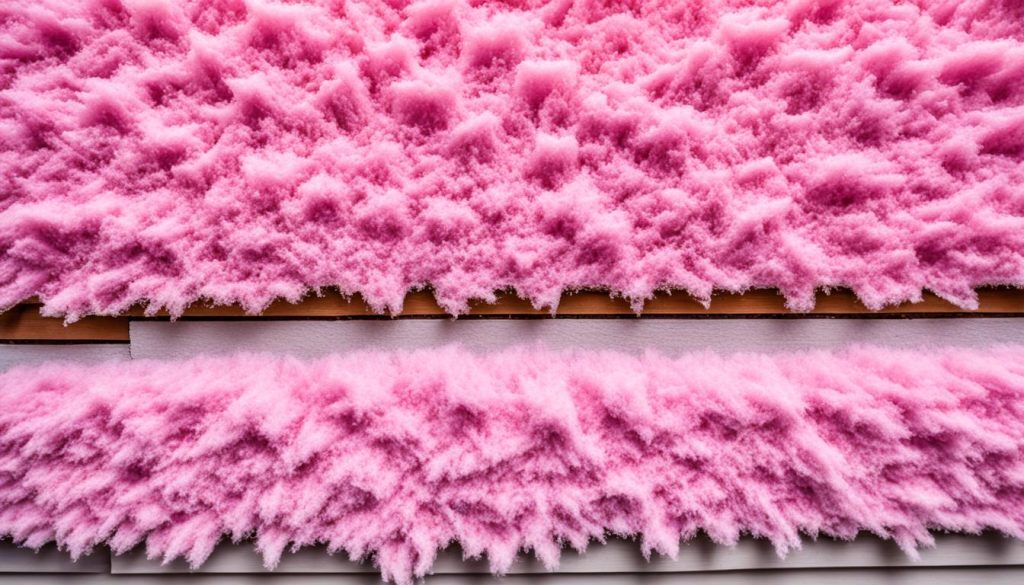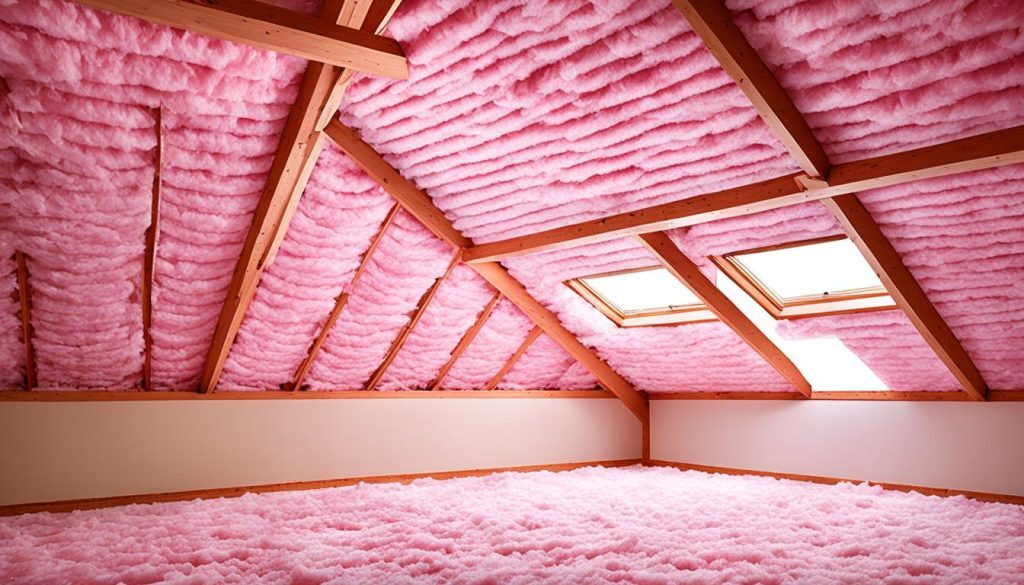Did you know that the pink fluffy stuff commonly found in the walls of homes is not just any ordinary material? It is a type of insulation known as fiberglass, and its presence in our walls has a significant impact on our daily lives. But what exactly is fiberglass insulation and why is it used so extensively? Let’s delve into the secrets of this pink fluffy stuff and explore the benefits it offers for our homes.
Key Takeaways:
- Fiberglass insulation, also known as the pink fluffy stuff, is a common type of insulation found in walls.
- It is made from glass fibers that are spun into a fluffy, cotton candy-like form.
- Fiberglass insulation is widely used in exterior walls, attics, and basements for its insulating properties.
- Over time, fiberglass insulation can deteriorate and pose health risks due to mold growth, brittleness, and the release of microscopic glass toxins.
- Considering alternative insulation materials can improve insulation and air quality in our homes.
How does fiberglass insulation affect air quality?
As fiberglass insulation ages, it can become brittle and release microscopic glass toxins into the air. This can compromise the air quality of a building and lead to respiratory issues, such as dry throat, coughing, and skin and eye irritation. Additionally, water damage or disturbances to the insulation can accelerate its breakdown and release more harmful particles into the air. It is important to remove and replace old fiberglass insulation to improve the overall air quality and reduce health risks.
In older buildings, the fiberglass insulation used decades ago may have deteriorated over time, resulting in potential health hazards. Microscopic glass toxins can be released into the air, affecting the well-being of occupants. These toxins can irritate the respiratory system, causing symptoms like dry throat, coughing, and skin and eye irritation. Toxins exposure may have serious long-term health risks.
Water damage or disturbances to fiberglass insulation, such as renovations or repairs, can also speed up the breakdown of the material, releasing even more harmful particles into the air. These particles can further degrade air quality and pose risks to the health of those living or working in the space.
To combat these issues, it is recommended to remove and replace old fiberglass insulation with safer alternatives. By taking this step, you can improve the overall air quality in your building and reduce the potential health risks associated with microscopic glass toxins. It’s essential to prioritize the health and well-being of occupants by ensuring a clean and healthy environment.
Are there alternatives to fiberglass insulation?
When it comes to insulating your home, there are several alternatives to fiberglass insulation that can provide better insulation and mitigate health risks. Let’s explore some of these alternative insulation materials:
- Cellulose Insulation: Made from recycled newspapers, cellulose insulation offers a more eco-friendly option. It is less expensive than fiberglass insulation and has better insulation properties.
- Rock Wool: Made from minerals and other materials, rock wool is an excellent choice for insulation against both sound and heat. It is highly effective and can improve energy efficiency.
- Vermiculite: Derived from a volcanic mineral, vermiculite can also be used for insulation. However, it is not as commonly used due to trace amounts of asbestos found in some sources.
These alternative insulation materials provide safer and more effective options for insulating your walls. Consider consulting with a professional insulation installer to determine the best alternative insulation material for your home.
How does insulation work?
Insulation is a vital component in maintaining a desired temperature indoors, whether it’s keeping warm air inside during the winter or preventing heat from entering during the summer. Understanding how insulation works can help you make informed decisions about improving the energy efficiency of your home.
Insulation works by utilizing an effective insulation mechanism that involves trapping air bubbles within its material. These air bubbles act as barriers, impeding the transfer of heat through various methods: conduction, convection, and radiation.
Conduction
When it comes to heat transfer through conduction, insulation plays a crucial role in reducing direct contact between objects that have different temperatures. The tiny air bubbles within insulation limit the direct transfer of heat, helping to keep the temperature inside your home more stable.
Convection
Convection refers to the transfer of heat through the movement of fluids or gases. Insulation with air-filled pockets interrupts the movement of air within the insulation material, reducing convective heat transfer. This mechanism further enhances the insulation’s ability to maintain a comfortable temperature in your living spaces.
Radiation
Radiation occurs when heat is transferred through electromagnetic waves. The incorporation of air bubbles within insulation helps to obstruct the movement of these waves, reducing the transfer of heat through radiation. This provides an additional layer of insulation, contributing to better energy efficiency.
By harnessing the insulation mechanism that relies on air bubbles and effectively minimizing heat transfer through conduction, convection, and radiation, insulation helps to create a thermal barrier in your home’s walls, ceilings, and floors. This barrier ensures optimal energy efficiency, reduces heat loss or gain, and ultimately leads to greater cost savings on heating and cooling expenses.
Now that you have a better understanding of how insulation works, you can make informed decisions about the best insulation materials and techniques to optimize energy efficiency and create a more comfortable living environment.

Why is attic insulation important in warm weather?
During the warm summer months, attic insulation plays a critical role in maintaining a comfortable indoor temperature and promoting energy efficiency. Properly insulated attics act as a barrier, preventing the intrusion of hot outdoor air into your living spaces. This insulation helps to reduce the need for excessive cooling, resulting in lower energy bills and a more environmentally friendly home.
According to the Energy Star program, which promotes energy efficiency, the recommended attic insulation levels range from R49 to R60. These insulation levels ensure optimum protection against heat transfer and contribute to energy savings. With adequate attic insulation, your home can stay cooler for longer periods, reducing the strain on HVAC systems and improving overall energy efficiency.
Moreover, ensuring your attic insulation meets local standards is essential for optimal thermal performance. It not only helps to maintain a more comfortable living environment, but it also aligns with modern building codes and regulations. Investing in proper attic insulation guarantees a more enjoyable summer experience while reaping the benefits of energy savings.

| Benefits of Attic Insulation in Warm Weather | Importance |
|---|---|
| Controls heat transfer from the outdoors | Prevents excessive cooling requirements |
| Reduces energy consumption and lowers utility bills | Energy-efficient solution |
| Improves overall comfort in living spaces | Maintains desired indoor temperature |
| Reduces strain on HVAC systems | Enhances system efficiency and longevity |
Choose the right insulation for your home
When it comes to ensuring proper insulation in your home, it’s always a smart move to consult with a professional insulation installer. They have the expertise to inspect and measure your current insulation, recommend the best options, and ensure compliance with local building codes. By trusting the professionals, you can have peace of mind knowing that your insulation needs are in good hands.
One popular choice for adding or replacing insulation is blown-in insulation. This method provides thorough and effective coverage, allowing you to maximize energy savings and create a more comfortable living environment. With blown-in insulation, you can achieve a higher level of insulation compared to other traditional methods, resulting in improved energy efficiency throughout your home.
When it comes to professional insulation installation and roofing services, Yellowhammer Roofing in Birmingham, Alabama is a name you can trust. Their team of experts is dedicated to providing top-notch insulation solutions to make your home cozy, comfortable, and energy-efficient. Whether you’re looking to upgrade your insulation or need assistance with other roofing services, Yellowhammer Roofing is the go-to choice for homeowners in the area.
